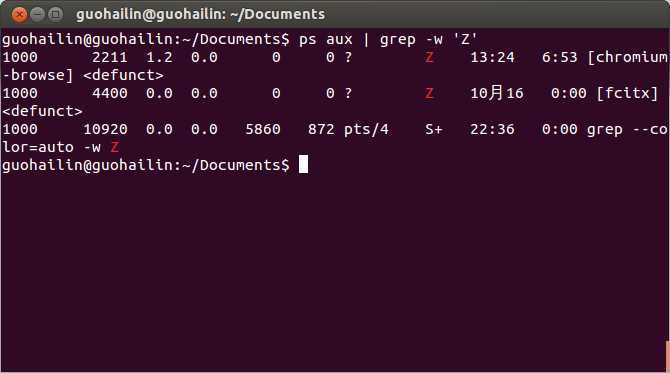标签:style blog http io color ar 使用 for sp
Linux 系统中僵尸进程
Linux 系统中僵尸进程和现实中僵尸(虽然我也没见过)类似,虽然已经死了,但是由于没人给它们收尸,还能四处走动。僵尸进程指的是那些虽然已经终止的进程,但仍然保留一些信息,等待其父进程为其收尸。
僵尸进程如何产生的?
如果一个进程在其终止的时候,自己就回收所有分配给它的资源,系统就不会产生所谓的僵尸进程了。那么我们说一个进程终止之后,还保留哪些信息?为什么终止之后还需要保留这些信息呢?
一个进程终止的方法很多,进程终止后有些信息对于父进程和内核还是很有用的,例如进程的ID号、进程的退出状态、进程运行的CPU时间等。因此进程在终止时,回收所有内核分配给它的内存、关闭它打开的所有文件等等,但是还会保留以上极少的信息,以供父进程使用。父进程可以使用 wait/waitpid 等系统调用来为子进程收拾,做一些收尾工作。
因此,一个僵尸进程产生的过程是:父进程调用fork创建子进程后,子进程运行直至其终止,它立即从内存中移除,但进程描述符仍然保留在内存中(进程描述符占有极少的内存空间)。子进程的状态变成EXIT_ZOMBIE,并且向父进程发送SIGCHLD 信号,父进程此时应该调用 wait() 系统调用来获取子进程的退出状态以及其它的信息。在 wait 调用之后,僵尸进程就完全从内存中移除。因此一个僵尸存在于其终止到父进程调用 wait 等函数这个时间的间隙,一般很快就消失,但如果编程不合理,父进程从不调用 wait 等系统调用来收集僵尸进程,那么这些进程会一直存在内存中。
在 Linux 下,我们可以使用 ps 等命令查看系统中僵尸进程,僵尸进程的状态标记为‘Z’:
 产生一个僵尸进程
根据上面的描述,我们很容易去写一个程序来产生僵尸进程,如下代码:
#include <stdio.h>
#include <sys/types.h>
int main()
{
//fork a child process
pid_t pid = fork();
if (pid > 0) //parent process
{
printf("in parent process, sleep for one miniute...zZ...\n");
sleep(60);
printf("after sleeping, and exit!\n");
}
else if (pid == 0)
{
//child process exit, and to be a zombie process
printf("in child process, and exit!\n");
exit(0);
}
return 0;
}
父进程并没有写 wait 等系统调用函数,因此在子进程退出之后变成僵尸进程,父进程并没有为其去收尸。我们使用下面命令编译运行该进程,然后查看系统中进程状态:
guohailin@guohailin:~/Documents$ gcc zombie.c -o zombie
guohailin@guohailin:~/Documents$ ./zombie
in parent process, sleep for one miniute...zZ...
in child process, and exit!
# 打开另一个终端:
guohailin@guohailin:~$ ps aux | grep -w ‘Z‘
1000 2211 1.2 0.0 0 0 ? Z 13:24 6:53 [chromium-browse] <defunct>
1000 4400 0.0 0.0 0 0 ? Z 10月16 0:00 [fcitx] <defunct>
1000 10871 0.0 0.0 0 0 pts/4 Z+ 22:32 0:00 [zombie] <defunct>
从上面可以看出,系统中多了一个僵尸进程。但如果等父进程睡眠醒来退出之后,我们再次查看系统进程信息,发现刚才的僵尸进程不见了。
guohailin@guohailin:~/Documents$ ./zombie
in parent process, sleep for one miniute...zZ...
in child process, and exit!
after sleeping, and exit!
guohailin@guohailin:~/Documents$ ps aux | grep -w ‘Z‘
1000 2211 1.2 0.0 0 0 ? Z 13:24 6:53 [chromium-browse] <defunct>
1000 4400 0.0 0.0 0 0 ? Z 10月16 0:00 [fcitx] <defunct>
这是为什么呢?父进程到死都也没有为其子进程收尸呀,怎么父进程退出之后,那个僵尸进程就消失了呢?难道父进程在退出时会为子进程收拾吗?其实不然....真正的原因是:父进程死掉之后,其所有子进程过继给 init 进程,init 进程成为该僵尸进程的新进程,init 进程会周期性地去调用 wait 系统调用来清除它的僵尸孩子。因此,你会发现上面例子中父进程死掉之后,僵尸进程也跟着消失,其实是 init 进程为其收尸的!
怎样避免僵尸进程的产生
不能使用 kill 后接 SIGKILL 信号这样的命令像杀死普通进程一样杀死僵尸进程,因为僵尸进程是已经死掉的进程,它不能再接收任何信号。事实上,如果系统中僵尸进程并不多的话,我们也无需去消除它们,少数的僵尸进程并不会对系统的性能有什么影响。
那么在编程时,如果能避免系统中大量产生僵尸进程呢?根据上面描述的,子进程在终止时会向父进程发 SIGCHLD 信号,Linux 默认是忽略该信号的,我们可以显示安装该信号,在信号处理函数中调用 wait 等函数来为其收尸,这样就能避免僵尸进程长期存在于系统中了。示例代码如下:
#include <stdio.h>
#include <signal.h>
#include <string.h>
#include <sys/types.h>
#include <sys/wait.h>
sig_atomic_t child_exit_status;
void clean_up_child_process(int signal_num)
{
/* clean up child process */
int status;
wait (&status);
/* store its exit status in a global variable */
child_exit_status = status;
}
int main()
{
/* handle SIGCHLD by calling clean_up_child_process */
struct sigaction sigchild_action;
memset(&sigchild_action, 0, sizeof(sigchild_action));
sigchild_action.sa_handler = &clean_up_child_process;
sigaction(SIGCHLD, &sigchild_action, NULL);
/* fork a child, and let the child process dies before parent */
pid_t c_pid;
c_pid = fork();
if (c_pid > 0)
{
printf("in parent process, and sleep for on mininute...zZ...\n");
sleep(60);
}
else if(c_pid == 0)
{
printf("in child process, and exit now\n");
exit(0);
}
else
{
printf("fork failed!\n");
}
return 0;
}
产生一个僵尸进程
根据上面的描述,我们很容易去写一个程序来产生僵尸进程,如下代码:
#include <stdio.h>
#include <sys/types.h>
int main()
{
//fork a child process
pid_t pid = fork();
if (pid > 0) //parent process
{
printf("in parent process, sleep for one miniute...zZ...\n");
sleep(60);
printf("after sleeping, and exit!\n");
}
else if (pid == 0)
{
//child process exit, and to be a zombie process
printf("in child process, and exit!\n");
exit(0);
}
return 0;
}
父进程并没有写 wait 等系统调用函数,因此在子进程退出之后变成僵尸进程,父进程并没有为其去收尸。我们使用下面命令编译运行该进程,然后查看系统中进程状态:
guohailin@guohailin:~/Documents$ gcc zombie.c -o zombie
guohailin@guohailin:~/Documents$ ./zombie
in parent process, sleep for one miniute...zZ...
in child process, and exit!
# 打开另一个终端:
guohailin@guohailin:~$ ps aux | grep -w ‘Z‘
1000 2211 1.2 0.0 0 0 ? Z 13:24 6:53 [chromium-browse] <defunct>
1000 4400 0.0 0.0 0 0 ? Z 10月16 0:00 [fcitx] <defunct>
1000 10871 0.0 0.0 0 0 pts/4 Z+ 22:32 0:00 [zombie] <defunct>
从上面可以看出,系统中多了一个僵尸进程。但如果等父进程睡眠醒来退出之后,我们再次查看系统进程信息,发现刚才的僵尸进程不见了。
guohailin@guohailin:~/Documents$ ./zombie
in parent process, sleep for one miniute...zZ...
in child process, and exit!
after sleeping, and exit!
guohailin@guohailin:~/Documents$ ps aux | grep -w ‘Z‘
1000 2211 1.2 0.0 0 0 ? Z 13:24 6:53 [chromium-browse] <defunct>
1000 4400 0.0 0.0 0 0 ? Z 10月16 0:00 [fcitx] <defunct>
这是为什么呢?父进程到死都也没有为其子进程收尸呀,怎么父进程退出之后,那个僵尸进程就消失了呢?难道父进程在退出时会为子进程收拾吗?其实不然....真正的原因是:父进程死掉之后,其所有子进程过继给 init 进程,init 进程成为该僵尸进程的新进程,init 进程会周期性地去调用 wait 系统调用来清除它的僵尸孩子。因此,你会发现上面例子中父进程死掉之后,僵尸进程也跟着消失,其实是 init 进程为其收尸的!
怎样避免僵尸进程的产生
不能使用 kill 后接 SIGKILL 信号这样的命令像杀死普通进程一样杀死僵尸进程,因为僵尸进程是已经死掉的进程,它不能再接收任何信号。事实上,如果系统中僵尸进程并不多的话,我们也无需去消除它们,少数的僵尸进程并不会对系统的性能有什么影响。
那么在编程时,如果能避免系统中大量产生僵尸进程呢?根据上面描述的,子进程在终止时会向父进程发 SIGCHLD 信号,Linux 默认是忽略该信号的,我们可以显示安装该信号,在信号处理函数中调用 wait 等函数来为其收尸,这样就能避免僵尸进程长期存在于系统中了。示例代码如下:
#include <stdio.h>
#include <signal.h>
#include <string.h>
#include <sys/types.h>
#include <sys/wait.h>
sig_atomic_t child_exit_status;
void clean_up_child_process(int signal_num)
{
/* clean up child process */
int status;
wait (&status);
/* store its exit status in a global variable */
child_exit_status = status;
}
int main()
{
/* handle SIGCHLD by calling clean_up_child_process */
struct sigaction sigchild_action;
memset(&sigchild_action, 0, sizeof(sigchild_action));
sigchild_action.sa_handler = &clean_up_child_process;
sigaction(SIGCHLD, &sigchild_action, NULL);
/* fork a child, and let the child process dies before parent */
pid_t c_pid;
c_pid = fork();
if (c_pid > 0)
{
printf("in parent process, and sleep for on mininute...zZ...\n");
sleep(60);
}
else if(c_pid == 0)
{
printf("in child process, and exit now\n");
exit(0);
}
else
{
printf("fork failed!\n");
}
return 0;
}
http://www.cnblogs.com/hazir/p/zombie_process.html
标签:style blog http io color ar 使用 for sp
原文地址:http://www.cnblogs.com/leijiangtao/p/4075942.html